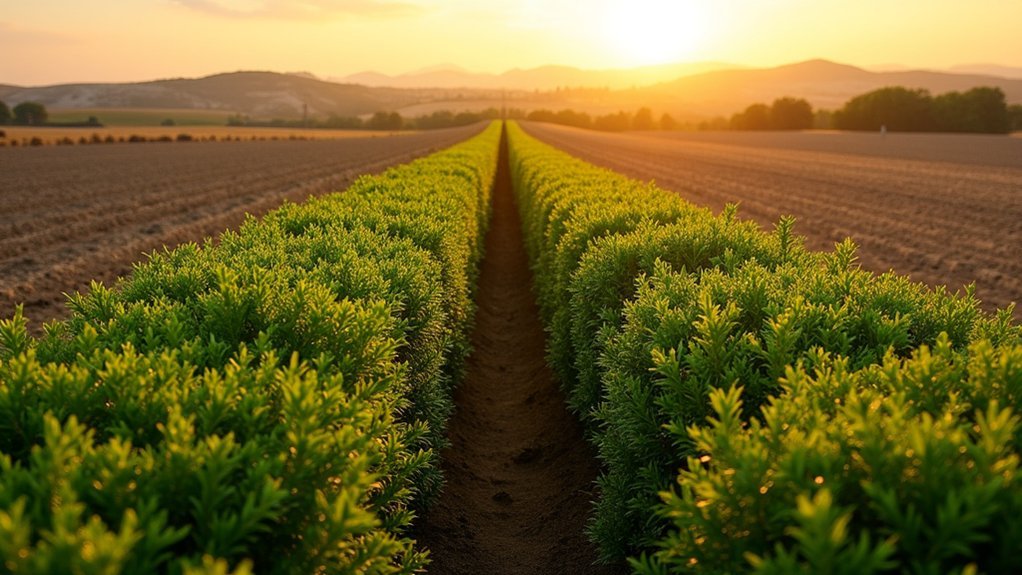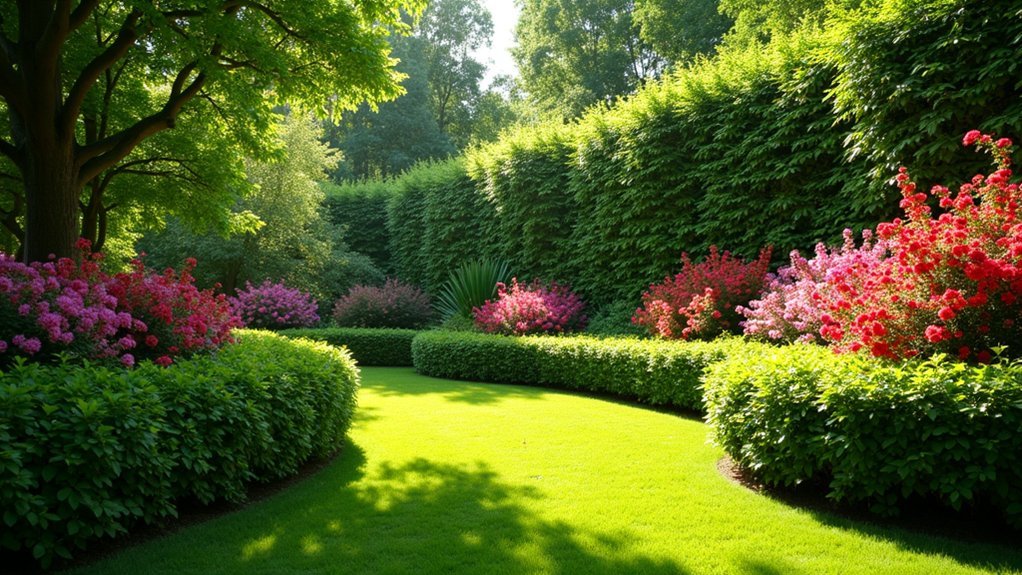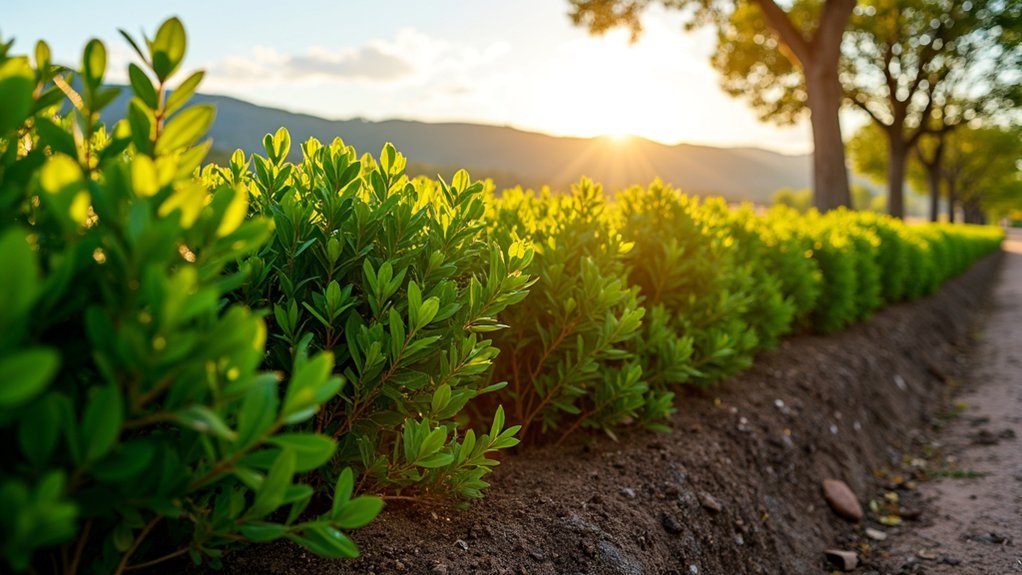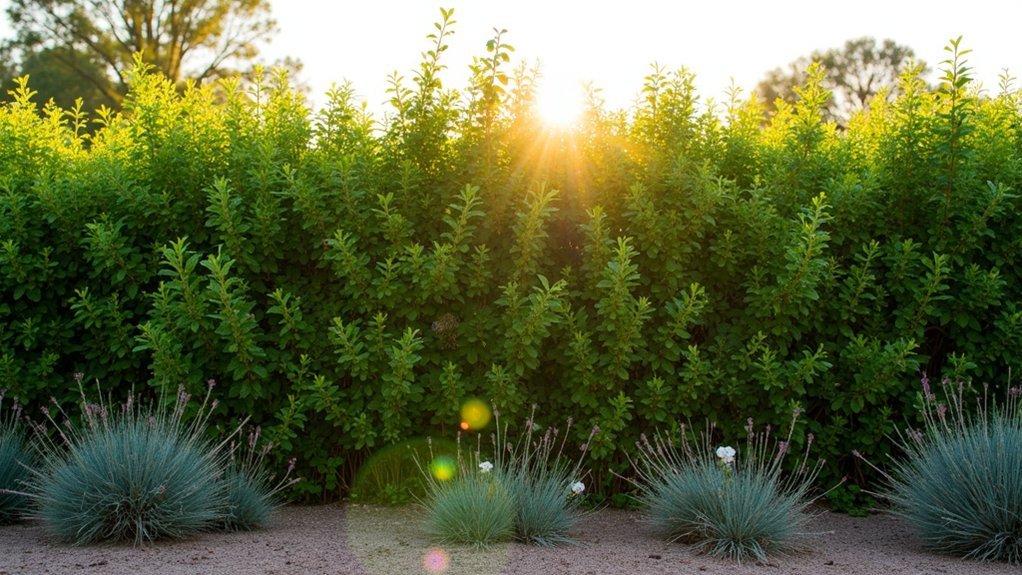Heat-resistant hedgerows create effective privacy while supporting wildlife and conserving water. You’ll find success with boxwood varieties (Green Mountain, Green Tower), privet, holly, hibiscus, Indian hawthorn, and California privet—all thriving in hot zones 5-9. For drought-defying options, consider Bluebeard and Abelia that create natural microclimates. Add 3 inches of mulch and implement structured watering to maintain these boundaries. The following guide reveals maintenance strategies that’ll transform your landscape’s resilience.
The Benefits of Heat-Resistant Hedgerows in Changing Climates

As our climate continues to warm, heat-resistant hedgerows offer multiple advantages for both agricultural settings and natural ecosystems.
You’ll find these specialized plants create effective privacy screens while simultaneously supporting diverse wildlife that can adapt to rising temperatures.
When you establish heat-resistant hedgerows, you’re investing in natural water conservation systems that capture rainfall and reduce evaporation during intense heat events.
Their dense foliage creates cooling microclimates and shields surrounding areas from harsh winds.
Beyond protection, these hedgerows continue sequestering carbon effectively even as temperatures rise, directly contributing to climate change mitigation.
You can also diversify your income by incorporating drought-tolerant fruits, nuts, and herbs into your hedgerow design, ensuring sustainability despite unpredictable weather patterns.
Key Factors to Consider When Selecting Heat-Tolerant Boundary Plants
When selecting heat-tolerant boundary plants, you’ll need to match their soil and moisture requirements to your specific garden conditions, looking for species with deep root systems that can access water during dry periods.
Your hedgerow’s long-term success depends on choosing plants with high drought tolerance, such as varieties that develop waxy leaves and reduced transpiration rates in hot conditions.
Assess potential growth rates carefully, as fast-establishing plants like Privet provide quicker protective barriers, while slower-growing varieties might offer better long-term structure and density for your heat-resistant boundary.
Soil and Moisture Requirements
Selecting the right soil and moisture conditions stands as a fundamental prerequisite for establishing successful heat-resistant hedgerows. You’ll need to prioritize soil drainage, as excess moisture often leads to root rot in heat-tolerant plants.
Aim for soil with a pH between 6.0 and 7.5 to guarantee ideal nutrient availability for your boundary plants.
Consider plants with deep root systems that can access subsoil moisture during drought periods. These species typically demonstrate better resilience in heat-prone environments.
Most heat-tolerant plants prefer low to moderate humidity settings, so assess your local climate carefully before making selections.
Regular soil testing is invaluable for monitoring nutrient levels and moisture retention capabilities. This practice guarantees your chosen hedgerow plants receive proper conditions for establishment and sustained growth, even during challenging temperature extremes.
Drought Tolerance Considerations
Successful heat-resistant hedgerows depend critically on your plant’s ability to withstand prolonged dry periods. When selecting heat-tolerant boundary plants, prioritize species with established drought tolerance like Indian Hawthorn and Hibiscus, which thrive in Zones 7-10 with minimal watering after establishment.
Look for shrubs with deep root systems, such as Cherry Laurel, that can access moisture from lower soil layers during dry spells. Native and locally adapted species typically demonstrate superior resilience to both heat stress and water scarcity, making them ideal choices for sustainable boundaries.
Consider growth rates carefully—fast-growing varieties establish quickly but may demand more initial irrigation.
Plants with dense foliage offer an added advantage by shading the soil, reducing evaporation and improving moisture retention throughout your hedgerow system.
Growth Rate Assessment
Three fundamental growth rate considerations must guide your heat-tolerant hedgerow decisions.
First, determine your timeline—fast-growing varieties like hibiscus and privet establish boundaries quickly, providing immediate privacy screens and windbreaks in hot conditions. They’ll fill gaps rapidly, giving you functional results within seasons rather than years.
Alternatively, slower-growing heat-tolerant plants offer long-term advantages through reduced maintenance requirements. They typically need less frequent pruning and often develop deeper root systems that adapt exceptionally well to harsh conditions.
Always align your selected growth rate with specific landscape goals. If you’re seeking immediate privacy, prioritize faster-growing options. For sustainable, lower-maintenance boundaries, slower growers excel.
Remember to regularly monitor your plants’ development to verify they’re thriving in your specific heat zone, adjusting care as needed.
Boxwood Varieties That Thrive in High-Temperature Environments
When temperatures soar, many hedges wilt under pressure, but certain boxwood varieties stand out for their remarkable heat tolerance. Green Mountain and Green Tower boxwoods flourish in USDA Zones 5-9, making them ideal choices for your sun-baked landscape.
These evergreen shrubs maintain their dense, vibrant foliage year-round, creating consistent privacy screens even during intense heat waves.
Unlike deciduous options, these robust boxwoods deliver year-round privacy with lush, unfading greenery—even as temperatures climb to uncomfortable heights.
You’ll appreciate their slow growth rate, which translates to less maintenance and pruning while still providing structural integrity for your boundaries.
To maximize their heat resistance, apply a layer of mulch around the base to preserve soil moisture.
For quicker privacy results, you can plant these boxwoods closer together than their mature width—they’ll still thrive despite the competition, creating robust, heat-resistant hedgerows that define your space beautifully.
Privet and Holly: Traditional Hedges With Impressive Heat Resistance

Stalwarts of the landscaping world, privet and holly have earned their reputation as go-to hedging options for heat-challenged environments.
Privet thrives in USDA Zones 7-11, offering fast-growing screening that withstands intense heat while attracting beneficial pollinators to your garden.
You’ll find holly equally impressive with its year-round evergreen foliage and remarkable heat-resistant properties.
Varieties like Ruby Colonnade® and Emerald Colonnade® perform exceptionally well in Zones 5-9, adapting to various soil conditions even during prolonged warm periods.
Both these traditional choices provide the dense foliage necessary for effective privacy screening.
When you’re establishing boundaries in hot climates, these hardy options deliver reliable performance without sacrificing structure or appearance.
Their ability to maintain robust growth despite temperature extremes makes them invaluable additions to heat-stressed landscapes.
Native Drought-Tolerant Shrubs for Natural Living Boundaries
Native shrubs adapted to your local climate offer exceptional drought tolerance while creating stunning natural boundaries that outperform many conventional options. When creating hedges, choose varieties like Salvia and Ceanothus, which develop deep roots that stabilize soil and enhance water retention.
| Shrub Type | Benefits | Ideal Height |
|---|---|---|
| Salvia | Attracts pollinators | 2-5 feet |
| Ceanothus | Nitrogen fixing | 3-10 feet |
| Manzanita | Erosion control | 2-6 feet |
| Toyon | Bird habitat | 8-15 feet |
| Cleveland Sage | Fragrant | 3-5 feet |
You’ll find these native drought-tolerant shrubs require minimal irrigation once established. For a low hedge under 3 feet, consider compact varieties of manzanita or salvias. Their resistance to local pests and ability to thrive in poor soils makes them sustainable choices for beautiful, resilient boundaries.
Flowering Heat-Resistant Hedges for Beauty and Function

You’ll find vibrant, year-round blooms possible even in scorching climates with heat-resistant flowering hedges like Hibiscus and Indian Hawthorn.
These drought-defying flower walls combine practical boundary-setting with spectacular seasonal color, attracting beneficial pollinators to your landscape.
Colorful Year-Round Blooms
While functional barriers remain essential for property definition, today’s heat-resistant hedges offer far more than just privacy and wind protection.
You’ll discover vibrant flowering hedges that transform ordinary boundaries into showcases of color and texture throughout the seasons.
Hibiscus varieties like Jazzy Jewel® Ruby and Chateau™ de Chantilly deliver tropical splendor with their glossy foliage and bold blooms, thriving even in the hottest zones.
For consistent color, Indian hawthorn combines dense growth with profuse spring flowering, creating both beauty and functional screening while supporting pollinators.
Fast-establishing California Privet produces fragrant white flowers that complement its reliable heat resistance.
Drought-Defying Flower Walls
Transforming ordinary boundaries into lush floral showcases, drought-defying flower walls offer the perfect solution for gardeners facing water restrictions and scorching temperatures.
These heat-resistant barriers combine beauty and function while conserving precious water resources.
You’ll find varieties like Hibiscus and Indian Hawthorn thrive effortlessly in Zones 7-10, delivering vibrant blooms alongside essential privacy.
By selecting drought-tolerant flowering shrubs such as Bluebeard and Abelia, you’re creating more than just boundaries—you’re establishing vital pollinator habitats that enhance your garden’s overall health.
The dense foliage of these flowering shrubs guarantees privacy year-round, while their colorful displays create visual interest throughout the growing season.
This smart landscaping approach provides both practical protection and aesthetic appeal, all while standing strong against summer’s most punishing heat.
Creating Microclimates With Strategically Placed Hedgerows
As temperatures continue to rise globally, strategic placement of hedgerows offers one of the most effective natural solutions for creating beneficial microclimates.
You’ll find these living boundaries work tirelessly to moderate your garden’s environment by providing shade, reducing wind speed, and retaining precious moisture.
When you position hedgerows thoughtfully around your property, they create protective zones where temperatures remain noticeably cooler during heat waves.
Their dense foliage shields sensitive plants from harsh sun exposure while simultaneously improving humidity levels and reducing evaporation rates.
The biodiversity these hedgerows support—from pollinators to beneficial insects—further stabilizes your garden’s microclimate.
They’re natural air conditioners that require no electricity, just proper planning.
Maintenance Strategies for Heat-Stressed Boundary Plantings

Once established, heat-resistant hedgerows require specific maintenance practices to thrive during extreme temperature events.
Implement a structured irrigation schedule—weekly watering in the first year, biweekly in the second, and monthly by the third year—to develop deep, resilient root systems.
Apply at least 3 inches of organic mulch around your plants to conserve moisture and suppress weed competition.
You’ll want to regularly check soil moisture using a meter if available, as both over and under-watering can intensify heat stress.
Select heat-tolerant varieties like hibiscus and privet that flourish in zones 7-11 for greater success.
Your maintenance strategies should include scheduled pruning to enhance air circulation through the foliage, preventing heat buildup that can damage even resilient plants during temperature extremes.
Combining Different Species for Resilient, Layered Hedgerows
You’ll find that mixing different shrub species in your hedgerow creates an ecosystem that’s more resilient to heat stress than a single-species approach.
This diversity allows for staggered bloom times, ensuring your boundary planting provides continuous food sources for pollinators throughout the growing season.
The layered structure resulting from combining tall, medium, and low-growing plants maximizes both the aesthetic appeal and ecological value of your heat-resistant hedgerow.
Mixed-Species Benefits
While traditional single-species hedgerows offer basic protection, mixed-species plantings create resilient, layered defenses against extreme heat.
These diverse hedgerows greatly enhance biodiversity by providing varied habitats that support a wider range of wildlife than monotonous alternatives.
You’ll find that mixed-species hedgerows optimize water management naturally.
Plants with varying root depths access moisture from different soil layers, dramatically improving drought resistance in heat-prone areas.
This structural diversity also creates a more robust ecosystem that effectively resists pests and diseases.
The flowering plants in your diverse hedgerow will attract beneficial insects and pollinators, boosting nearby crop yields while promoting ecological health.
Additionally, the complex root systems of varied plantings enhance nutrient cycling and reduce soil erosion—critical benefits for maintaining productive boundaries in challenging climates.
Staggered Bloom Times
Staggered bloom times create a continuous flowering calendar throughout the growing season when you combine different species in your hedgerow design.
By selecting plants with varied flowering periods, you’ll support a diverse range of pollinators that are essential for food production.
Consider which plants will fit your climate while providing sequential blooms. Best shrubs for this approach include fast-growing privet paired with slower-developing boxwood—giving you immediate coverage while establishing long-term structure.
This layering technique does more than create visual interest; it builds ecological resilience by developing multi-tiered habitats that can withstand climate fluctuations.
Your carefully timed flowering sequence supports beneficial insects year-round, improving your garden’s ecosystem and potentially boosting nearby crop yields through enhanced pollination services.
The result: a hedgerow that’s both beautiful and functional across seasons.
Case Studies: Successful Heat-Resistant Hedgerow Installations

As climate challenges intensify across regions, innovative landscapers and homeowners have implemented remarkable heat-resistant hedgerow solutions worth examining. You’ll find that these real-world applications demonstrate how thoughtfully selected plants create effective boundaries while thriving in harsh conditions.
| Location | Plant Species | Key Benefits |
|---|---|---|
| Arizona | Abelia, Barberry | 40% reduced water usage |
| Texas | Indian Hawthorn | Temperature reduction of 8°F |
| California | Mixed Natives | Enhanced pollinator activity |
| Nevada | Drought-tolerant Mix | 65% decrease in maintenance |
| New Mexico | Desert Adapted | Improved soil stability |
These case studies prove that heat-resistant hedgerows don’t just survive—they flourish. By selecting regionally appropriate species, you’ll create resilient boundaries that require minimal intervention while providing privacy, reducing temperatures, and supporting local ecosystems.
Frequently Asked Questions
What Is the Best Hedge to Block Neighbors?
For blocking neighbors, you’ll want fast-growing shrubs like privet or hibiscus. They create dense barriers quickly. Boxwood offers formal privacy, while cherry laurel and holly provide year-round coverage at heights of 6-8 feet.
What Plants Are Good for Boundary Hedges?
You’ll find boxwood, holly, privet, cherry laurel, and Indian hawthorn make excellent boundary hedges. They all offer dense foliage that provides privacy while defining your property line with attractive greenery year-round.
What Is the Best Border Hedge?
The best border hedge depends on your climate and needs. You’ll find boxwood ideal for formal looks, privet for fast growth, cherry laurel for privacy, and hibiscus for colorful boundaries in warmer zones.
What Are the Fastest Growing Hedges for Privacy?
For quick privacy, you’ll find Privet growing up to 3 feet yearly, Cherry Laurel reaching full height in 3-5 years, and Hibiscus adding 2-3 feet annually. Lilacs and Indian Hawthorn also establish rapidly.
In Summary
You’ll find these heat-resistant hedgerows offer the perfect solution for creating strong boundaries in challenging climates. They’re not just practical barriers but ecological assets that withstand rising temperatures while supporting local wildlife. By selecting the right combination of species and implementing proper maintenance techniques, you’ll enjoy resilient, attractive boundaries that thrive for years, even as our climate continues to change.





Leave a Reply